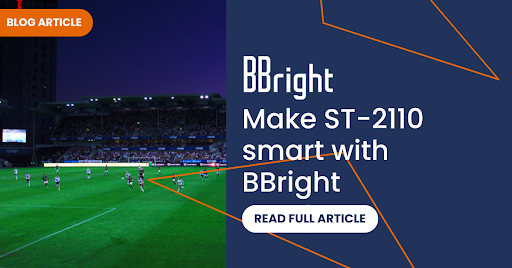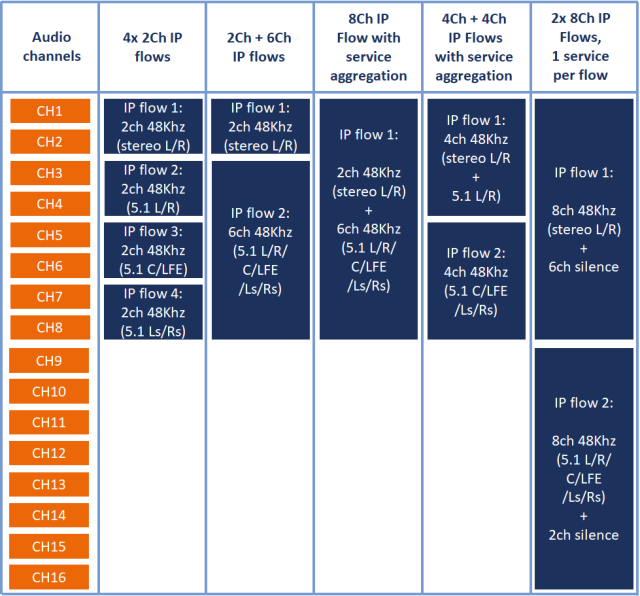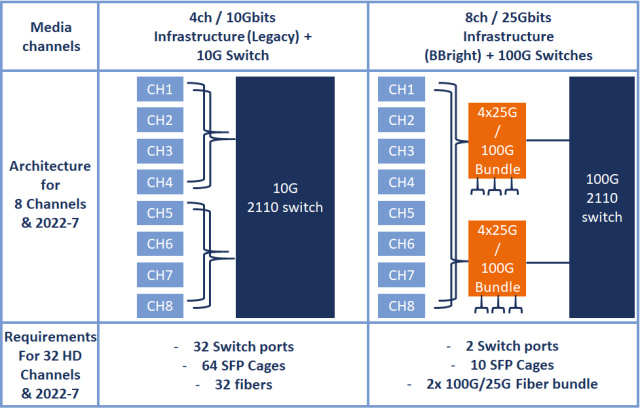
Hot topic: the migration to pure IP infrastructures to handle live content transport over IP!
Last update: August 1st 2023
Relying on our experience with large 2110 deployments in Europe and North America to leading broadcasters since 2020, BBright is excited to announce yet more enhancements to our contribution and playout solutions to make IP migration easier. The emergence of the ST 2110 format has multiplied the possible variations of implementation (audio mapping, timing, NMOS…), and most manufacturers have chosen a limited number of formats. Despite the undeniable efforts of interoperability tests, it is often complicated to interconnect 2110 equipment from several manufacturers, and it is unfortunately too often necessary to integrate many converters or 2110 gateways in a complete workflow.These solutions are costly and energy-consuming. They also complicate IP routing needs.
That’s why since day 1 of its work on the 2110, BBright has been focusing on adding maximum flexibility and density to simplify integration with other manufacturers and make the 2110 as simple as the good old SDI “plug and play”.

Classic topics such as PTP or NMOS must be treated with attention to facilitate interoperability (BBright supports for example both mDNS and SD-DNS modes for NMOS recording of its resources), but the purpose of this article is to take an interest in several points which can be really helpful when comes 2110 deployment.
Here are some examples of features that facilitate 2110 deployment with BBright contribution and playout solutions.
1/ Take care of audio mapping!
One of the advantages of the ST 2110 is the diversity of supported audio formats. Where SDI was limited to 16 audio channels (4 groups of 2 pairs), the 2110 allows many variations: stereo audio stream, stream of 4, 8 or more… A real headache is that sometimes it is necessary to integrate dedicated processors for audio shuffling / conversion and allow several devices to communicate with each other.
BBright has decided to offer maximum flexibility on this subject:
- Support for multiple audio streams of 2, 4 or 8 channels per IP stream (ST-2110-30).
- Support 2110-31
- Up to 64 audio channels per video stream
- Possibility to have audio streams of different configuration on the same channel (Stereo and 5.1 for example)
- Level A and level C audio support (1ms or 125us)
You will always have the possibility of “fine tuning” your solution to respect the constraints of other equipment.
The following table presents for example the case of possible ST2110-30 formatting to transmit a stereo service and a 5.1 service. Note that BBright solutions can manage all of these cases (and even more!), both in packets of 1ms (Level A) or 125us (Level C), ideal flexibility to interface natively with the greatest number of devices.
Some possible 2110-30 Audio mapping to transport Stereo + 5.1 services
The diagram above represents only a few examples of audio mapping, but BBright playout solutions are for example capable of outputting up to 64 24-bit 48 KHz audio channels in 2110-30 or -31.
2/ Think about your network!
A significant part of the deployment costs comes from IP infrastructure: Switches, Fibers, SFP cages… BBright has chosen to maximize the density of its solutions to reduce its costs. With 25Gbps ports as standard on its 2110 solutions, up to 8 full HD channels (or two UHD) can be transported on a single link (SFP Cage / Fiber / Switch Port). In addition, these 25 Gbps ports are optimally interconnected with 100Gbits/s switches (increasingly standard) via the use of 100Gbits/s to 4x25Gbits/s bundles. Simply minimize the number of switch ports, fibers and cages.
And because a network problem can always happen, the native support for 2022-7 redundancy on all of our solutions guarantees a perfect quality of service.
The following table illustrates the benefits of a high density approach for 2110 based on 25Gbits NIC.
How high density 2110 can make your IT easier
3/ How about playing around with the JPEG-XS?
Standardized through the VSF-TR08 and ST2110-22, the use of JPEG-XS allows visually lossless, very low latency compression of the video stream and thus reduces the bandwidth required for 2110 deployment. For example, this allows transport of a UHD signal in JPEG-XS compression in a bandwidth initially calibrated for a baseband HD signal.
Thanks to the flexibility of its pure software architecture and its partnership with IntoPIX, BBright solutions can activate or not the JPEG-XS compression dynamically (with adjustable bit rate) according to the needs of your 2110 transport network and your other equipment.
An essential point for interfacing with the cloud: Jpeg-XS also makes it possible to transport UltraHD signals over a typical network bandwidth from 1 to 3 Gbits/s, ideal for connecting to virtual switches limited to 10Gbits/s. It’s also a great way to minimize bandwidth costs to get in and out of the cloud.
With its contribution over IP, playout and analysis solutions, BBright can facilitate your 2110 deployments in many cases. BBright 2110 solutions includes Contribution, Playout, Monitoring and Lab sources.
4/ Boost your metadata with the 2110!
First, the ST-2110-40 standard offers an easy and equivalent transposition of SDI metadata (HANC & VANC) in the full IP 2110 environment. Simple, and perfect for managing a transition from good old SDI to 2110. Anyway, this SDI type metadata (ST-292 type) is both packetized, and limited to existing metadata in the SDI world.
The new standards under discussion ST2110-41/42 will deal with the transport and formatting of new data to be synchronized (or not) with video and audio. Ideal, for example, to take into account the transport of XML-type metadata, which is too bulky and not well suited to the constraints of historical SDI HANC/VANC metadata. These new standards will open up a large number of new applications, for example around the transport of metadata linked to spatialized audio (SADM) or even HDR. Same evolution for subtitling data, with the emergence of 2110-43 allowing the transport of TTML (Timed Text Markup Language) subtitles.
Conclusion
The 2110 is now a reality, used and widely deployed. Many advantages of the 2110 are not yet fully exploited, and workflows can still be optimized and simplified. Rather than multiple converters and gateways, BBright offers to integrate maximum flexibility and functionality on its 2110 interfaces, and thus allow native interfacing with other industry solutions.
About BBright
BBright develops and markets high-end Broadcast processing solutions capable of creating, transporting, and transmitting the best multimedia content: Ultra HD, HDR, NGA Audio, … BBright deploys its solutions for decoding, ingesting, playback and monitoring in leading operators: content providers, Broadcasters, OTT service providers, etc. www.bbright.com
For more info, please contact sales@bbright.com



